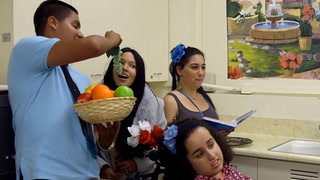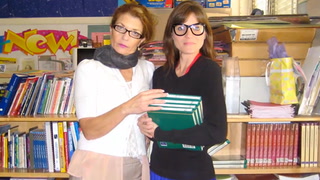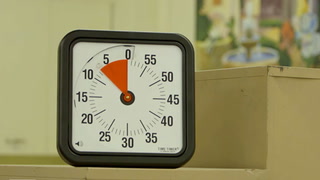Building Analysis Skills Through Art Transcript
LINDSAY YOUNG [sync]
00:00:00 When was the last time you took a picture? Raise your hand if it was today. A selfie?
LINDSAY YOUNG
00:00:05 My name is Lindsay Young and I teach 9th through 12th grade English Language Development. My students are not only in mild to moderate special education, but they’re also long term English language learners.
00:00:20 We have been working on generating literal and inferential questions, but when we read text it’s difficult to get them to make inferences.
00:00:29 [TITLE: Arts Integration:]
[TITLE: Building Analysis Skills]
[TITLE: A Two Day Lesson]
LINDSAY YOUNG
00:00:34 The reading levels in my class range from 2nd to 7th grade. And then you’re trying to get them to do this critical analysis, which is also challenging. Why would you teach two challenging things at one time? So, the thought process is look at art, teach them how to analyze, then they’ll know how to analyze, so then you can have them look at a text and now the challenging thing is no longer the analysis.
00:00:59 Because they know how to do that. Now, the only challenging thing that we’re dealing with is reading.
LINDSAY YOUNG [sync]
00:01:04 Okay, so can anybody else tell me the last picture that they posted on Facebook or Instagram or Snapchat?
DAVID
00:01:11 A drink in Starbucks at Vaughn’s – my workplace.
LINDSAY YOUNG [sync]
00:01:15 Of- That is a great one. Okay, that’s a great one because that says so many things about you right off the bat.
LINDSAY YOUNG
00:01:21 So, I started class today with an attention-grabber by making the students realize every time they take a picture and put it on Facebook or Instagram, they’re creating art. And they’re analyzing it the same way we would analyze a piece of art in a museum.
LINDSAY YOUNG [sync]
00:01:37 What does that say about David?
STUDENT
He likes coffee.
LINDSAY YOUNG [sync]
00:01:40 Yeah, okay. So, he likes coffee. That coffee’s a prop. But second of all, the setting at his job. He is employed. And that- and that’s a cool thing to be, right? These are all things that you look at when you take pictures and you show them to people you’re trying to send a message.
LINDSAY YOUNG
00:01:58 I had the graphic organizer on the white board, poster-sized. And I tried to get the students to mention all of the elements I was looking for – the clothing, gesture, posture, facial expression, setting, and props.
00:02:11 When David said that he had a Starbucks cup in his hand and I said, “Okay, Starbucks – that’s a prop.” So, I went ahead and just put a check by that. And then setting – he mentioned he was at work, so I put a check by setting. It’s just so important, especially with English language learners to have visual representation.
LINDSAY YOUNG [sync]
00:02:31 Before photos, they had portraits. And this was a painting of one person or a group of people. I want everybody to circle the word “portrait.” But you guys are lucky because how many pictures can you take in one minute?
RED HAT
A lot.
LINDSAY YOUNG [sync]
00:02:47 Tell me.
STUDENT
Forty.
STUDENT
Probably 30.
STUDENT
25.
LINDSAY YOUNG [sync]
00:02:50 How long do you think it took to paint a portrait?
STUDENT
Months at a time.
LINDSAY YOUNG [sync]
Months at a time. So, you only had one picture of yourself. So, you thought of everything. Nothing was done on accident. If they were holding a Starbucks, which they weren’t because this was a long time ago, but there would be a definite reason.
00:03:07 So, today, we’re going to read portraits like we would read a story. Here is our first portrait that we’re going to look at.
LINDSAY YOUNG
00:03:18 The next step was look at portraits and then I put up a piece of Getty artwork. And we’re going to read art just like we would a text, using all of the elements that you just talked about. But I also said, “We’re going to do close reading. I’m just going to focus on clothing and setting,” because I felt at this point, they’re most familiar with that.
00:03:38 [TITLE: CLASSROOM STRATEGY]
[TITLE: Focus on a limited number of elements to support student learning]
LINDSAY YOUNG [sync]
00:03:43 We’ve all learned the word literal and we’ve been working on that. So, it’s right here. Underline it on your paper, the word “literal.” Who can tell me what this means? You can what to it?
STUDENT
00:03:56 You can just point to it.
LINDSAY YOUNG [sync]
Yes! You can just point to it. Guys, write that in. You can point to it.
LINDSAY YOUNG
00:04:02 The reason that I have the graphic organizer up and I’m saying, “Okay, circle this. Underline this,” is because I need an opportunity to model, but I also need to make sure that they’re somehow actively engaged.
LINDSAY YOUNG [sync]
00:04:17 So I’m going to start with clothing and I’m just going to look at the children. Things I can point to – the children are wearing white dresses. So, I’m going to write it right there – three children wearing white dresses.
00:04:30 [TITLE: LITERAL OBSERVATIONS]
[TITLE: Three Children Wearing White Dresses]
LINDSAY YOUNG [sync]
00:04:34 Now, we’ve talked about this before, we’ve talked about inference. And I want everybody to draw a line under “inference,” please. If you’re making an inference, you must give what?
STUDENT
00:04:47 Evidence.
LINDSAY YOUNG [sync]
Evidence. You must give evidence. Yes, and you guys, we have done all the work here. Because this literal information – this is our evidence. Now, it’s our job to make the inference and figure out what this means.
00:05:01 Here’s what I would think – three children wearing white dresses. When do I usually see people wearing white?
STUDENT
When someone’s getting married.
STUDENT
Weddings.
LINDSAY YOUNG [sync]
00:05:09 Good.
STUDENT
Or in their baptizing.
LINDSAY YOUNG [sync]
Yes! So, then I think, “Why do brides wear white when they get married?”
STUDENT
00:05:15 Because they’re virgins.
LINDSAY YOUNG [sync]
So, what could white represent?
STUDENTS
Purity.
LINDSAY YOUNG [sync]
00:05:19 Purity. Ex- You guys are expert inference makers. So, the fact that they’re all wearing white shows that they’re pure. I can use this language to make the inference.
00:05:30 [TITLE: INFERENCES]
[TITLE: Pure and Innocent]
LINDSAY YOUNG [sync]
00:05:31 I can say, “I see three children wearing white dresses. This shows that they are pure and innocent.” Now, can anybody wear silk or satin?
JOSE
00:05:41 No. Just upper class people.
LINDSAY YOUNG [sync]
Upper class people.
BLACK TANK TOP
When they’re, like, rich.
LINDSAY YOUNG [sync]
Rich. Exactly.
00:05:47 [TITLE: Common Core Standard]
[TITLE: Present information and evidence so listeners can follow the reasoning]
LINDSAY YOUNG [sync]
00:05:51 The inference is they are upper class or rich.
LINDSAY YOUNG
00:05:55 The final project of the lesson is the students are creating their own portraits. So, they just learned how to analyze art using all the elements, and they have the graphic organizer. Now, they all get different portrait scenarios. And they weren’t supposed to let the other groups see because it’s going to be kind of like a competition.
00:06:14 The group that analyzes correctly – literal observations and inferences – is going to win a prize.
LINDSAY YOUNG [sync]
00:06:22 I’m going to read it out loud, okay? This is a family portrait of a grandmother, grandfather, and their two grandchildren. Okay? Whom they take care of.
LINDSAY YOUNG
00:06:34 When they receive the portrait scenarios, instead of first pointing out what’s literal, they have to work in reverse.
LINDSAY YOUNG [sync]
00:06:41 How are you going to show the first thing that you are the grandmother and grandfather?
YANDIRA
He has to wear, like a beard.
ALFRED
Glasses.
YANDIRA
Something old-fashioned, you know? Because they’re grandparents. So, you guys have to wear old-fashioned.
LINDSAY YOUNG [sync]
00:06:55 So, here, under inferences, write “Grandmother and Grandfather,” because that’s the inference we’re trying to get them to catch. Okay? And then for the literal thing, what should she write, guys? Tell her what to write.
YANDIRA
00:07:07 Nice clothes?
ALFRED
Like, tuck their clothes on.
LINDSAY YOUNG [sync]
Okay. Tucked in shirt. I have a button- We have button down shirts and ties.
ALFRED
[unintell]
LINDSAY YOUNG [sync]
Okay.
LINDSAY YOUNG
00:07:15 So, we brainstormed in our small groups. When we knew the props and background we were going to choose, we went over to the props. And I have a lot of props in my room.
LINDSAY YOUNG [sync]
00:07:27 Okay, okay, okay. Anyway.
LINDSAY YOUNG
Then we used Photobooth to choose the backgrounds, so we could choose anything from Google Images. That was fun. And they took their photo.
00:07:39 The curriculum comes from the Getty Center and they have an amazing website that has so many teacher resources. On it. So, I took this lesson from their ESL curriculum.
00:07:49 [TITLE: CLASSROOM RESOURCES]
[TITLE: Search Lesson & Activities on www.Getty.edu]
LINDSAY YOUNG
00:07:51 And I actually tweaked it for my students, which was the end project, which was having them create their own portraits. In the next lesson, they’ll have their printed out photo and they’ll show it to the class and the class will have to make literal observations and inferences.
00:08:10 Today they really learned what it means to be an artist because they had to create their own portraits. How every choice that they make, they’re trying to get their audience to get something from it – the artist’s intent. So, when we look at a text now, and I say, “Why do you think that the author chose to use these words?” or “Why did the author choose this setting?” I think that they really got the idea that nothing is on accident.
00:08:39 There’s a purpose behind every decision - the author’s intent. And that adds a little bit of mystery.
00:08:46 [TITLE: Lesson 2: Using Analysis Skills]
LINDSAY YOUNG
00:08:50 Today, the students received their portraits back and the goal was for them to try to analyze each other’s portraits using the same graphic organizer where they made the literal observations and then the inferences.
LINDSAY YOUNG [sync]
00:09:03 The group that makes the most literal observations, paired with an inference, wins. So, I want to show you what I mean by that. So, if I put my example up, my example’s on the board, I ask you to make a literal observation about the props, what would you say?
STUDENT
00:09:20 Books.
LINDSAY YOUNG [sync]
Books. Yes. The literal observation about the props would be “books.” Now, what could the possible inference be?
STUDENT
It means you like to study.
STUDENT
Library.
LINDSAY YOUNG [sync]
Yeah, okay. Let’s go with that. Let’s go with they like to study.
00:09:35 So, I just want to be clear about this – to get a point, you must have the correct literal observations and the correct inference. And this is hard because you’re going to have to read the artists’ intent. So, we might get it wrong sometimes. It doesn’t mean that it was an incorrect inference or that you didn’t have the right evidence.
00:09:55 It just means sometimes we don’t know what the artist was thinking.
LINDSAY YOUNG
00:09:58 The next step was for us to break into small groups. During this part, one group is getting ready to present their portrait. The other two groups – they had 4 x 6’s of the portrait. And they were going through a smaller version of the graphic organizer, writing down what they thought the answers were.
HEADBAND
00:10:19 In the background looks like they’re in a big community and there are people.
LINDSAY YOUNG
00:10:24 The purpose was twofold. They were making literal observations and inferences off of those, but also this is the part of the lesson where they really get to understand artist’s intent.
BLACK LONG SLEEVE
00:10:37 Is that cards or money?
BLACK HOODIE
I think money he’s holding [unintell].
LINDSAY YOUNG
00:10:43 So, then from the group whose portrait was being analyzed, a student came up and kept score at the board and checked the answers.
LINDSAY YOUNG [sync]
00:10:50 Let’s hear about the props.
DAVID
There was a book. So, we thought he was an educated boy. There is a racquet in the picture, so we thought it was rich, sporty girl. And cards that we thought meant he was a gambler.
LINDSAY YOUNG [sync]
00:11:08 Okay. Rita, will you come up here and keep score for the next two? So, let’s go to facial expression.
JOSE [sync]
00:11:16 Facial expression – Rita’s lips are straight, so she might be serious. And Alfred’s biting his lip, so again, that’s curiosity and fascination for what he’s doing.
00:11:28 [TITLE: Common Core Standard]
[TITLE: Present information and evidence so listeners can follow the reasoning]
JOSE
00:11:31 Like the saying goes, a picture’s worth a thousand words. But they need to be interpreted and you just need literacy.
LINDSAY YOUNG [sync]
00:11:38 Should we give that to them? He said that- What did you say again?
JOSE [sync]
00:11:42 Straight lips.
LINDSAY YOUNG [sync]
We said straight face means that she’s strict. What do you think, artists?
STUDENT
No.
LINDSAY YOUNG [sync]
No? I think that group’s going to remember that if you get close. Okay.
LINDSAY YOUNG
00:11:53 Very few students figured out what the artists’ intent was. But the goal was that they make those literal observations and they make evidence-based inferences. And they did that incredibly well. Very successful. I was pleased. But I should have warned them and said, “Don’t expect it’s always going to match what the artist’s intent is.”
00:12:17 Today, they were reading people. They will use this skill more than they know now.
YANDIRA
00:12:25 When I used to go to museums, they were boring for me. But now, they’re, like, interesting because I’m gonna look at the picture and see what they’re holding, or their expressions, and their settings. Because they mean something to them.
00:12:41 I look at the art different now.
00:12:46 ***FILE END***












48 Comments
LaBresha Small Sep 25, 2023 8:40pm
coells Wells May 10, 2023 4:59pm
How does Ms. Young connects analysis skills to her student's lives?
She creates an attention grabber. In this case, pictures are something students can identify with, they take selfies and post pictures on social media pages. She first teaches them how to analyze the picture. She uses the suggestion from one of the students who took a picture of himself, drinking coffee at work, although she did not see the picture, but from the oral presentation she was able to identify the prop and the setting and put them in the appropriate place on the graphic organizer. Although, she was showing them a period piece, it didn't matter what the time period was, a picture is still a picture, In the art picture, she makes references to the color of the girls' dresses and the type of material the clothes may have been made of. From this, students associated that with things that are familiar to them: an event such as a wedding, the color white symbolizing being pure and silk with being rich or being in an upper class. Once the students are able to identify these things, they can now analyis the complete picture by observing other things in the picture. The lesson scaffold toward literary analysis skills because it promotes critical thinking, it requires interpretation and telling the story from their own perspective.
Lisa Batchelder Feb 18, 2023 7:36pm
Tiffany Baltazar Jul 19, 2022 2:06pm
2.The kind of inferences the students make is looking at the art work to retell what the picture.
3. Ms. Young support students to use evidence by looking at the text.
4. This lesson scaffold students towards building literary analysis skills by using art to connect to the text and Ms. Young had the students to use a visual aid (graphic organizer)to complete another analytical task.
Walter Hardy May 8, 2022 5:02pm
Ms. Young did an excellant job of connecting her students to a real time real experience through this art exhibit that they commented on. The fact that she then had her students incorporate props into their fact finding and protocol they decided to use, this gave them a clear understanding of the action items she was displaying.